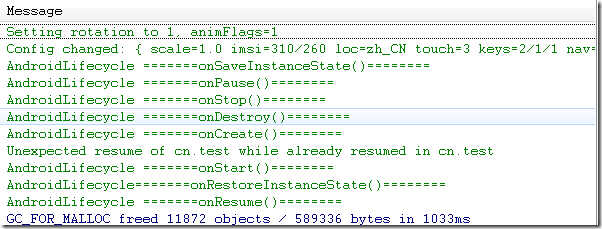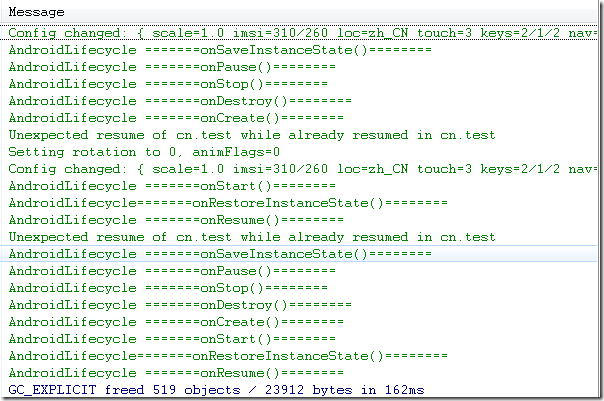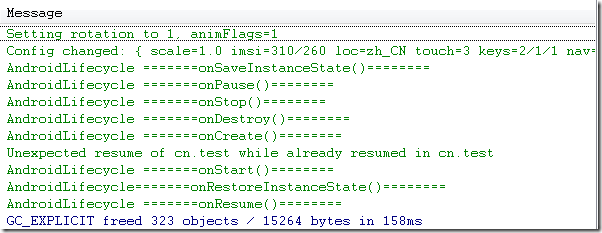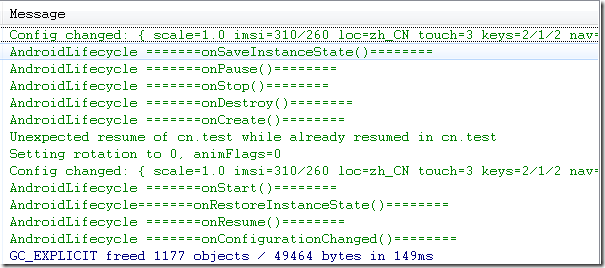一、Activity 的 ConfigChanges 属性
官方解释: 通过设置这个属性可以使Activity捕捉设备状态变化,以下是可以被识别的内容:
CONFIG_FONT_SCALE
CONFIG_MCC
CONFIG_MNC
CONFIG_LOCALE
CONFIG_TOUCHSCREEN
CONFIG_KEYBOARD
CONFIG_NAVIGATION
CONFIG_ORIENTATION
设置方法:将下列字段用“|”符号分隔开,例如:“locale|navigation|orientation”
Value
Description
“mcc“
The
IMSI mobile country code (MCC) has changed — that is, a SIM hasbeen
detected and updated the MCC.移动国家号码,由三位数字组成,每个国家都有自己独立的MCC,可以识别手机用户所属国家。
“mnc“
The IMSI mobile network
code (MNC) has changed — that is, a SIM hasbeen detected and updated the
MNC.移动网号,在一个国家或者地区中,用于区分手机用户的服务商。
“locale“
The locale has changed — for example, the user has selected a new language that text should be displayed in.用户所在地区发生变化。
“touchscreen“
The touchscreen has changed. (This should never normally happen.)
“keyboard“
The keyboard type has changed — for example, the user has plugged in an external keyboard.键盘模式发生变化,例如:用户接入外部键盘输入。
“keyboardHidden“
The keyboard accessibility has changed — for example, the user has slid the keyboard out to expose it.用户打开手机硬件键盘
“navigation“
The navigation type has changed. (This should never normally happen.)
“orientation“
The screen orientation has changed — that is, the user has rotated the device.设备旋转,横向显示和竖向显示模式切换。
“fontScale“
The font scaling factor has changed — that is, the user has selected a new global font size.全局字体大小缩放发生改变
项目的AndroidManifest.xml文件配置方法:
| 02 | package="com.androidres.ConfigChangedTesting" |
| 03 | android:versionCode="1" |
| 04 | android:versionName="1.0.0"> |
| 07 | android:label="@string/app_name" |
| 08 | android:configChanges="keyboardHidden|orientation"> |
二、横竖屏切换时候 Activity 的生命周期
测试代码:
| 01 | public class AndroidLifecycle extends Activity { |
| 02 | private String TAG = "AndroidLifecycle"; |
| 03 | public void onCreate(Bundle savedInstanceState) { |
| 04 | Log.i(TAG,"AndroidLifecycle =======onCreate()========"); |
| 05 | super.onCreate(savedInstanceState); |
| 06 | setContentView(R.layout.main); |
| 10 | protected void onSaveInstanceState(Bundle outState) { |
| 11 | Log.i(TAG,"AndroidLifecycle =======onSaveInstanceState()========"); |
| 12 | super.onSaveInstanceState(outState); |
| 16 | protected void onRestoreInstanceState(Bundle outState) { |
| 17 | Log.i(TAG,"AndroidLifecycle=======onRestoreInstanceState()========"); |
| 18 | super.onRestoreInstanceState(outState); |
| 22 | public void onConfigurationChanged(Configuration newConfig) { |
| 23 | Log.i(TAG,"AndroidLifecycle =======onConfigurationChanged()========"); |
| 24 | super.onConfigurationChanged(newConfig); |
| 27 | // Called after onCreate — or after onRestart when the activity had been |
| 28 | // stopped, but is now again being displayed to the user. It will be |
| 29 | // followed by onResume |
| 30 | protected void onStart() { |
| 31 | Log.i(TAG,"AndroidLifecycle =======onStart()========"); |
| 35 | // Called after onRestoreInstanceState, onRestart, or onPause, for your |
| 36 | // activity to start interacting with the user |
| 37 | protected void onResume() { |
| 38 | Log.i(TAG,"AndroidLifecycle =======onResume()========"); |
| 42 | // Called as part of the activity lifecycle when an activity is going into |
| 43 | // the background, but has not (yet) been killed |
| 44 | protected void onPause() { |
| 45 | Log.i(TAG,"AndroidLifecycle =======onPause()========"); |
| 49 | // Called when you are no longer visible to the user. You will next receive |
| 50 | // either onRestart, onDestroy, or nothing, depending on later user |
| 52 | protected void onStop() { |
| 53 | Log.i(TAG,"AndroidLifecycle =======onStop()========"); |
| 57 | // Perform any final cleanup before an activity is destroyed |
| 58 | protected void onDestroy() { |
| 59 | Log.i(TAG,"AndroidLifecycle =======onDestroy()========"); |
| 63 | // Called after onStop when the current activity is being re-displayed to |
| 64 | // the user (the user has navigated back to it). It will be followed by |
| 65 | // onStart and then onResume |
| 66 | protected void onRestart() { |
| 67 | Log.i(TAG,"AndroidLifecycle =======onRestart()========"); |
Activity属性配置:
| 03 | android:label="@string/app_name" |
| 04 | android:configChanges="orientation|keyboardHidden"> |
在 Android 2.2 模拟器上测试结果为:
1、不设置Activity的android:configChanges时:
 Simulator_切换到横屏
Simulator_切换到横屏
 Simulator_切换到竖屏
Simulator_切换到竖屏
模拟器这种情况切屏会重新调用各个生命周期,切横屏时会生命周期执行一次,切竖屏时生命周期会执行两次,且横竖屏onConfigurationChanged未被调用。但是在HTC DESIRE HD(G10) 这款手机上测试结果为:生命周期都只执行一次,且横竖屏onConfigurationChanged未被调用。
2、设置Activity的android:configChanges="orientation"时:
 Simulator_orientation_切换到横屏
Simulator_orientation_切换到横屏
 Simulator_orientation_切换到竖屏
Simulator_orientation_切换到竖屏
模拟器这种情况切屏还是会重新调用各个生命周期,切横屏onConfigurationChanged未执行、竖屏时onConfigurationChanged执行1次。但是在HTC DESIRE HD(G10) 这款手机上测试结果为:生命周期未发生变化,且横竖屏onConfigurationChanged都只执行一次。
3、设置Activity的android:configChanges="orientation|keyboardHidden"时:
 Simulator_orientation_keyboardHidden_切换到横屏
Simulator_orientation_keyboardHidden_切换到横屏
 Simulator_orientation_keyboardHidden_切换到竖屏
Simulator_orientation_keyboardHidden_切换到竖屏
模拟器这种情况切屏不会重新调用各个生命周期,切横屏时onConfigurationChanged会执行1次,切竖屏时onConfigurationChanged方法调用2次。 但是在HTC DESIRE HD(G10) 这款手机上测试结果为:横竖屏onConfigurationChanged都只执行一次。
结论:可以看出在G10这款真机上测试的结果比模拟器更加合理。
 Simulator_orientation_keyboardHidden_切换到横屏
Simulator_orientation_keyboardHidden_切换到横屏
 Simulator_orientation_keyboardHidden_切换到竖屏
Simulator_orientation_keyboardHidden_切换到竖屏